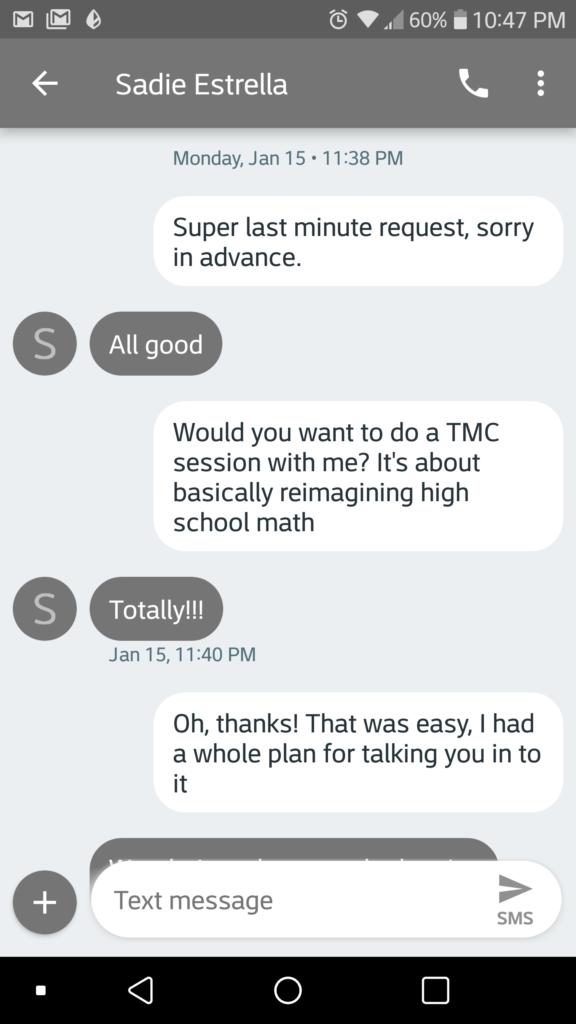I spent another day thinking about TMC related things, and I’ve decided to write some thoughts on the off chance that what I have to say might be valuable. Lots of people have very strong feelings about this, and I am trying to honor all of those people and their feelings while also offering some thinking about structure. Just so we’re clear, I don’t know what happened, or what may be in the works, or why anyone would want to read this. Let me go further to say that I am not really interested in keeping TMC nor am I attempting to minimize any harm that was experienced in order to revive #TMC19. The reason I keep thinking about it, and why I’m writing now, is that the model of teachers organizing on twitter to create their own PD is both powerful, and timely. Given today’s climate I think the biggest issues facing math education are going to come around ensuring equitable learning in a country that is very diverse and very unequal. The strategies to address these issues simply aren’t going to be one-size-fits-all solutions, and hard for typical PD to address. The kind of PD that would be best is going to be teacher-centered, with space for connections and reflection, organized collaboratively, and…well… look a lot like TMC. TMC’s concept and precedent, as well what I imagine are at least a bunch of dope presentations, are the things that could make a salvage attempt worthwhile. Of course large parts of the organization should change in order to make people feel safe and supported, and to make it a space to include educators of color, and to make it a place that could lead to the kind of change that math education needs. So much may need to be changed that it might not even make sense to call this future thing TMC. To emphasize that point I will stop using the phrase TMC in this post, and instead use the term “Unicorn Factory,” in order to keep this post future-focused.
Separate planning from the mission
When I look at the past few weeks I think more organizational structure would help. The Unicorn Factory structure would have at least two bodies a board who builds the organization, and one or more planning committees. The Board could ensure that UF is carrying out it’s mission and supporting the sub-committees that plan individual conferences. Right now it seems that the board of TMC is essentially doing both things. The “lean” board has the benefit of keeping business in a tight circle, it also makes it hard to know when you are living out your ideals, or rewriting them. Having separation would let a planning committee lean on an outside entity when one is needed. For example, if the planning brings up an issue that seems to threaten whether they are really living out the equity portion of the mission, they could go to the board who could provide a space and a process to look at the issue. If a matter is really complex, this board could take on the thorny issue so the planning committee can focus on making UF happen. During the actual conference I can see the need for a board that functions in this way as well. While the committee is focused on day to day, having people from the board on hand to talk about big picture ideals would really help. This way if you wonder where lunch is, and what the direction of the conference is taking in the next five years you aren’t directing it to the same person.
Organizing the board
So then what? Well if people think a group of educators can help bring on a change in the world through Unicorn Factory, and that change wouldn’t happen, any other way, here are some thoughts on the next steps. (This is basically how my old school found their union rep).
- Find a 3-5 person nomination committee who are impartial, i.e. not interested in being on the Unicorn Factory board, or planning UF, or presenting at UF.
- That committee could put out a call for nominations for the board that I just described.
- The nomination committee could filter through different nominations, reaching out to everyone who was nominated, seeing who is interested, and then creating a process for holding an election.
- Then the nominating committee holds an election with the fair process they describe
- Then that new board can look at a number of things. I’d think first would be norms and community agreements for their own functioning, followed by confirming or editing the mission, and then deciding whether #TMC19 could still happen and who should plan it.
Again, I’m just putting this out there because I hope it would be helpful. Apologies in advance if this may be poorly timed, insensitive, or disrespectful in any way.





